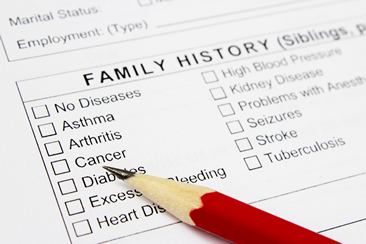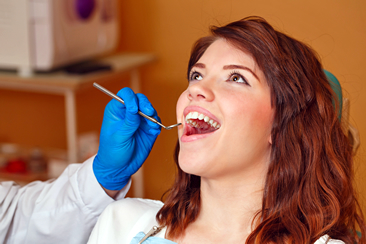What to Expect When You Visit Us
Almost everyone has gone to the dentist for a checkup. The dental hygienist is usually the one that cleans your teeth and makes an initial evaluation. About once a year, x-rays are taken. The dentist then will come in taking a close look at the X-rays and then your teeth and mouth. He or she is looking around for any indications of decaying teeth, changes to your gums and perhaps oral cancer or signs of other diseases.

We recommend taking x-rays once a year, x-rays show the dentist things they cannot see by looking in your mouth, like decay where your teeth touch shoulder to shoulder, how deep that decay is, how close is it to the nerve chamber, what the bone level looks like, the roots and tips of the teeth, the density of the bone at the tip of the tooth and pathology. Without x-rays, you could easily have a problem that cannot be seen with only a visual exam and that could develop into a more extensive problem. When a dental problem is detected and treated early, it is easier to fix, cost less and creates less sensitivity or perhaps none at all.
The first time you come to our office to meet the dentist, you will most likely be given a comprehensive examination. This will be done even if your teeth and mouth are in good shape from having regular care from another dentist. The first thing we want to do is develop a trusting relationship and become familiar with your teeth and overall health so that on future visits any changes or problem areas can more easily be noticed.
A comprehensive dental exam usually consists of certain standard activities on the part of the hygienist and the dentist, although everyone varies in terms of style and skill. If your comprehensive exam doesn’t include everything on this list, it may not necessarily indicate that we aren’t doing our job properly. But if you do have concerns, speak up and find out why certain areas were not checked and others were included in the exam.
Every dental office has their own procedures so do not expect the order of things to match this list precisely. And everything doesn’t need to be examined on every single appointment.
However, a crucial part of every dental checkup is keeping your medical history current. You need to tell us if there have been any changes in your general health or in the medications you’ve been taking since your last appointment.
Make sure that you discuss all aspects of your health with us, even if you don’t think it’s relevant to your teeth or mouth. There are many illnesses that certainly can have an impact on your dental health. Research is continually being done in the area of how oral health is affected by overall health and wellbeing. An example of this is the fact that diabetics have a higher risk of periodontal disease. There is also research that indicates that a periodontal infection can influence blood sugar levels in the person. It can also make it more difficult to control your diabetes. There are also certain health conditions that have an influence on which anesthesia we should use on you. So even if you don’t think it’s relevant, your overall health is important to us.
When visiting Natural Smiles make sure to bring a list with you of all your medications with the dosages for our team know of your health history. There are certain medicines that cause dry mouth and lead to a higher risk of dental decay. Another factor to be considered is the interaction between drugs. We want to know what you’re already taking before prescribing anything else.
 What We Want To Know
What We Want To Know
We should know about anything in order to help us properly diagnose you and give you the most appropriate care. These are the things you need to discuss with us:
All health issues
You should discuss your overall health and any diseases you’ve been diagnosed as having. If you are taking any prescription or over-the-counter medications you need to give your dentist the names and the dosages. This includes any medical condition that you think is not related to your mouth or dental care. We need to know everything about your health so we can determine the best treatment approaches to take care of your teeth and mouth.
Any fears you have
Very often patients are afraid of the dentist and these fears can start in childhood. You need to tell our team about your fears or any bad experiences you may have had because what you are most afraid of may no longer be an issue. The methods of dealing with pain are constantly improving for example. If you are worried that you’ve got a particular condition or disease, talk about it. Let him or she examine you for signs because so that you can either be diagnosed or be told you have nothing to worry about. Many times, just opening up about your fears helps relieve them.
Your overall dental health and history
Before the dental exam begins to inform your us if you suspect that you have a new cavity if your teeth have more sensitivity to cold or hot than in the past, and if you are feeling any lumps or sores anywhere inside your mouth.
Do not sit there silently wondering if he or she will spot something. If you suspect anything is wrong to discuss your concerns openly as this will save time and help in early detection.
 Comprehensive Dental Exam
Comprehensive Dental Exam
A comprehensive dental exam involves a lot more than the dentist looking at your teeth. You should expect our dentist to carefully examine all areas of your mouth and outside for any indication of problems or disease. Our dentist will likely examine the following areas:
Full head and neck area
Our dentist will carefully examine your head, neck, including your temporomandibular or jaw joint (TMJ), your salivary glands and the lymph nodes that are in the area of your neck, just below your jaw. He or she will also examine your face and lips for any swelling, bleeding, excessive dryness or anything unusual that might need to be looked into further.
The temporomandibular joint controls the lower jaw when opening or closing the mouth. Your dentist will have to move your lower jaw side-to-side and repeatedly open and close your mouth. This is to find out if your TMJ is working smoothly and properly. While you’re moving your jaw and mouth your dentist will likely be pressing on the joint to feel whether or not it’s catching or snapping which might indicate a problem. If you’ve been feeling any soreness or pain in that area your dentist will want to know.
During the exam, our dentist will be touching the area in your neck where the lymph nodes and glands are. If there’s swelling or you’re tender, you may have an active infection or disease. Your salivary glands will also be looked at and touched for any abnormalities.
Periodontal check of gums and supporting structures
A thorough examination of the gums and the area supporting your teeth will be done. Our dentist will be looking for red or puffy gums. He might gently poke them to see if they bleed. If they are red, puffy and do bleed you may have gum disease. A special probe might be used as a measuring device for the pockets between your teeth and the gums. If a pocket measures over 3m there might be a periodontal disease. If a determination is made that you do have periodontal disease, you may get a referral to a specialist who treats gum disease. These specialists are called periodontists.
Soft tissue in the mouth
Our dentist will thoroughly examine all the soft tissue for cuts, swelling, spots, growths or anything else that might be unusual or abnormal. The areas he will check are the inside of your lips and cheeks, your tongue, and the roof and floor of your mouth.
Occlusion or your bite
A comprehensive dental exam should include a check for how well your upper and lower teeth fit together. This is done by a thorough exam of your bite. You will first be asked to bite down naturally. If the dentist thinks they may not fit well together you may need to bite down on special paper or even wax. The paper is designed to leave small temporary marks on the surface of your teeth to indicate where they meet together. If biting down on wax your teeth will leave an impression that will show your bite and exactly how your teeth fit or don’t fit together.
Clinical dental examination
Using a mirror the dentist will closely examine each tooth for cavities and signs of decay. Your teeth will also be poked with a special tool called an explorer, which also helps in finding cavities. Tooth enamel that is decayed tends to be softer than the enamel on healthy teeth. Any fillings you have, crowns, permanent bridges or restorations need to be checked to make sure they are not loose and the teeth around them will be looked at too for any signs of decay.
X-rays will be taken
X-rays (radiographs) will need to be taken to the dentist can look for cavities or any other dental or oral health issues that can’t be seen by the naked eye during the dental exam. X-rays also help the dentist to see whether a root canal is needed, or if there is any bone loss due to gum disease.
Routine Check-ups
When you go for your routine dental checkup two of our dental professionals will often treat you, the hygienist if your office has one on staff and your dentist. The hygienist will see you first, checking your teeth and gums, cleaning and polishing your teeth. He or she will also discuss how to best take care of your teeth and gums at home. When our dentist comes in he or she will also do a clinical exam, diagnose any issues and recommend the appropriate treatment. This is what you should expect:
Teeth cleaning
When you brush and floss your teeth at home you are able to remove a build-up of plaque on the surface of your teeth. But only a professional dental cleaning can remove tartar, which is the hard calculus that forms on the teeth above and slightly below the gum line. Special dental instruments and tools are needed to remove calculus. Some hygienists have an ultrasonic instrument that effectively blasts away at the large pieces of tarter. Then using hand instruments and tools they are able to give the teeth a thorough cleaning. Other dental hygienists use hand instruments and tools only.
Tooth Polishing
Once all the calculus has been removed the surface of your teeth may need to be polished to remove any surface stains and any remaining plaque. Usually a mild abrasive is used on a small rotating brush or rubber cup. This is to effectively scrub any stains away. You will feel the abrasive material, which is gritty, but when this procedure is finished you can rinse your mouth out.
Oral Care and Prevention
When the hygienist is finished cleaning and polishing your teeth you will probably be given instructions on how to best care for your teeth, mouth, and gums. You may be given a demonstration on the best way to brush and floss your teeth. Some hygienists recommend using a disclosing agent on your teeth to determine if your brushing technique is removing all plaque. This is a tablet that can be chewed or it comes in a red colored solution. The disclosing agent adheres to plaque and highlights the areas that you missed when you were brushing.
Not every dental hygienist or dentist recommends using disclosing agents because there are certain areas that plaque may be in that can’t be removed by brushing alone. These areas need to be professionally polished. Some dental professionals recommend that a disclosing agent is used only in the dentist’s office so that the hygienist can polish and remove any red coloring after the brushing. But there are other dental professionals that do say that disclosing agents can be effectively used at home and they recommend them to their patients.

 What We Want To Know
What We Want To Know Comprehensive Dental Exam
Comprehensive Dental Exam